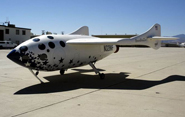22 October 2010
WASHINGTON—Rocket exhaust could become a significant contributor to global climate change in coming decades, according to a new study. The research finds that soot emitted by rockets — not their carbon dioxide emissions — has the greater potential to contribute to global climate change in coming decades.

Photo Credit: Courtesy of Scaled Composites, LLC.
New research finds that exhaust from space tourism rockets with hybrid engines may contribute to climate change. Powered by a hybrid engine using synthetic rubber and nitrous oxide for fuel, SpaceShipOne (above) rocketed to the edge of space in 2004 and won the $10 million X-prize.
The researchers assume that a fast-growing suborbital space tourism market will develop over the next decade and examine the climate impact of soot and carbon dioxide emissions from 1,000 suborbital rocket flights per year, the approximate number advertised in recent materials promoting space tourism.
“Rockets are the only direct source of human-produced compounds above about 14 miles [22.5 kilometers] and so it is important to understand how their exhaust affects the atmosphere,” says the study’s chief author, Martin Ross, of The Aerospace Corporation in El Segundo, California. He and his colleagues describe their findings in a scientific paper that has been accepted for publication in Geophysical Research Letters, a journal of the American Geophysical Union.
The study provides the first detailed look at how rockets using hydrocarbon fuel might affect Earth’s climate system The researchers find that soot particles emitted by the proposed fleet of space tourism rockets would accumulate in a stratospheric layer at about 40 kilometers (25 miles) altitude, three times the typical altitude of airline traffic. These particles efficiently absorb sunlight that would otherwise reach the earth’s surface, causing projected changes in the circulation of the earth’s atmosphere from pole to pole. Unlike soot from coal power plants or even jet aircraft, which falls out of the atmosphere in days or weeks, particles injected by rockets into the stratosphere remain in the atmosphere for years.
“The response of the climate system to a relatively small input of black carbon is surprising,” says Michael Mills of the National Center for Atmospheric Research in Boulder, Colorado, a study coauthor, “and our results show particular climate system sensitivity to the type of particles that rockets emit.” Even though the rockets are assumed launched from just one site in North America, the entire atmosphere adjusts to the rocket soot with a complex global pattern of change.
The study, which utilized a sophisticated computer model of the earth’s atmosphere, finds that beneath the thin stratospheric layer of rocket soot, which remains relatively localized in latitude and altitude, the earth’s surface could cool by as much as 0.7 degrees Celsius (1.2 degrees Fahrenheit). Meanwhile, Antarctica could warm by 0.8 degrees C (1.5 degrees F).
Ozone is also affected, with equatorial regions losing about one percent and the poles gaining about 10 percent. The globally integrated effect of these changes is, as for carbon dioxide, to increase the amount of solar energy absorbed by the earth’s atmosphere. In this case, as long as the launches continue at the assumed rate, soot from the suborbital rockets contributes to atmospheric heating at a rate significantly higher than the contribution from the carbon dioxide from those same rockets.
“The assumptions driving our calculations are consistent with business plans for commercial suborbital space travel in the year 2020” says Ross, “and perhaps they will not materialize. Nevertheless, our findings would also apply to the global fleet of hydrocarbon-fueled orbital rockets used today, though they emit about one tenth of the soot that we assumed in this study.”
“Climate impact assessments of suborbital and orbital rockets must consider black carbon emissions, or else they ignore the most significant part of the total climate impact from rockets,” he adds. “This includes existing assessments that may need to be brought up to date.”
Darin Toohey of the University of Colorado in Boulder, also a coauthor, says the team based its work on reasonable assumptions about rocket chemistry and atmospheric physics. “Yet we are unsure about actual rocket emissions,” he notes, adding that “measurements in actual rocket plumes and further climate modeling will be needed to gain confidence in these results.”
The research was funded by The Aerospace Corporation and NASA.
AGU Contact:
Peter Weiss, +1 202 777 7507, [email protected]
As of the date of this press release, the paper by Ross et al. is still “in press” (i.e. not yet published). Journalists and public information officers (PIOs) of educational and scientific institutions who have registered with AGU candownload a PDF copy of this paper.
Or, you may order a copy of the paper by emailing your request to Peter Weiss at [email protected]. Please provide your name, the name of your publication, and your phone number.
Neither the paper nor this press release are under embargo.
“Potential Climate Impact of Black Carbon Emitted by Rockets”
Martin Ross, Tel: +1 310-336-0360, Email: [email protected]
Michael Mills, Tel: (303) 497-1425, Email: [email protected]
Darin Toohey, Tel: +1 303-735-0002, Email: [email protected]